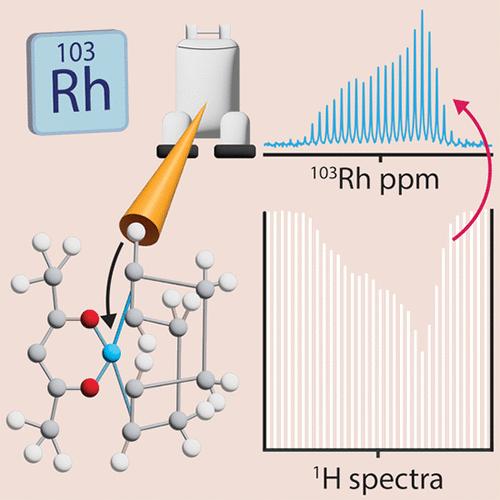固定样品中h -检测103Rh和99Ru固体核磁共振谱的获取
IF 4.6
2区 化学
Q2 CHEMISTRY, PHYSICAL
引用次数: 0
摘要
铂族元素(PGEs)是元素周期表中最重要的元素之一,因为它们在各种各样的应用中发挥着关键作用。从金属核素的角度出发,利用固态核磁共振(SSNMR)研究PGE配合物的结构和键合引起了人们极大的兴趣,但迄今为止这种研究还很有限。这主要是由于许多PGE核素固有的低拉莫尔频率,以及诸如低天然丰度和/或大各向异性相互作用等因素降低了它们对核磁共振实验的接受性。在这项工作中,我们首次证明了使用最近引入的质子库渐进饱和(PROSPR)脉冲序列,从含有103Rh (S = 1/2)和99Ru (S = 5/2)的化合物的固定样品中间接检测(1H, I = 1/2)宽线SSNMR粉末模式的能力。本文章由计算机程序翻译,如有差异,请以英文原文为准。

Acquisition of 1H-Detected 103Rh and 99Ru Solid-State Nuclear Magnetic Resonance Spectra in Stationary Samples
The platinum group elements (PGEs) are among the most important in the periodic table due to their critical roles in a diverse array of applications. There is great interest in using solid-state nuclear magnetic resonance (SSNMR) for studying the structure and bonding in PGE complexes from the perspective of the metal nuclides, yet this has been limited to date. This is largely due to the inherently low Larmor frequencies of many of the PGE nuclides in addition to factors such as low natural abundances and/or large anisotropic interactions that reduce their receptivity to the NMR experiment. In this work, we demonstrate for the first time the ability to indirectly detect (with 1H, I = 1/2) wideline SSNMR powder patterns from stationary samples of compounds featuring 103Rh (S = 1/2) and 99Ru (S = 5/2) using the recently introduced progressive saturation of the proton reservoir (PROSPR) pulse sequence.
求助全文
通过发布文献求助,成功后即可免费获取论文全文。
去求助
来源期刊

The Journal of Physical Chemistry Letters
CHEMISTRY, PHYSICAL-NANOSCIENCE & NANOTECHNOLOGY
CiteScore
9.60
自引率
7.00%
发文量
1519
审稿时长
1.6 months
期刊介绍:
The Journal of Physical Chemistry (JPC) Letters is devoted to reporting new and original experimental and theoretical basic research of interest to physical chemists, biophysical chemists, chemical physicists, physicists, material scientists, and engineers. An important criterion for acceptance is that the paper reports a significant scientific advance and/or physical insight such that rapid publication is essential. Two issues of JPC Letters are published each month.
 求助内容:
求助内容: 应助结果提醒方式:
应助结果提醒方式:


